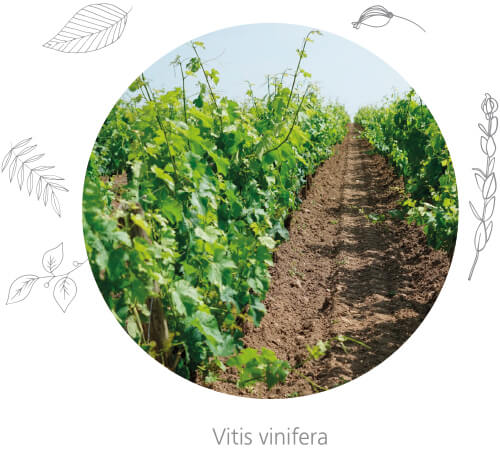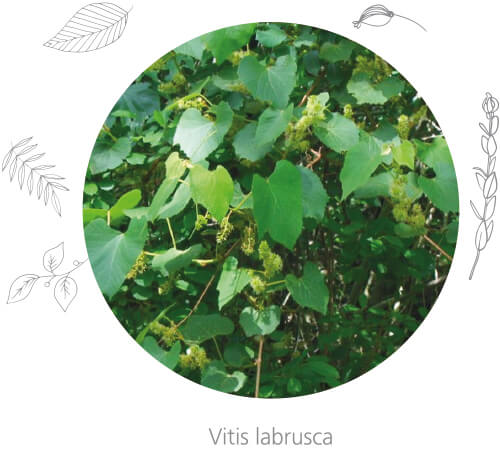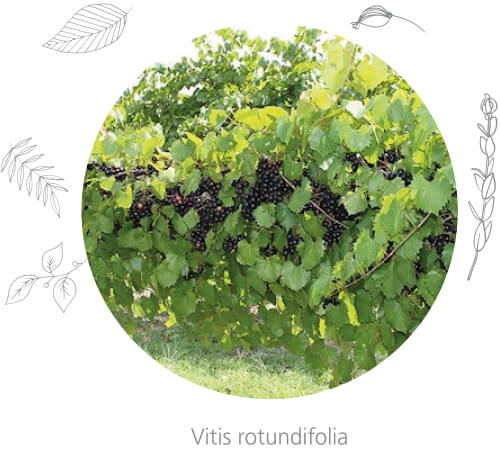-
Δωρεάν αποστολή στην Ελλάδα πάνω από 30€ !

-
Αποστολή εντός 24 ωρών!

-
Αποστολή σε όλο τον κόσμο!



ΡΕΣΒΕΡΑΤΡΟΛΗ
Τα σταφύλια, γνωστά από την αρχαιότητα, εκτός της χρήσης τους στην παραγωγή κρασιού, περιέχουν πολλές ουσίες με φαρμακολογικές ιδιότητες. Μια εξ αυτών η ρεσβερατρόλη απαλύνει τις λεπτές γραμμές και τις ρυτίδες και λειαίνει την υφή της επιδερμίδας. Επίσης, προστατεύει αποτελεσματικά τα κύτταρα της επιδερμίδας από αλλοιώσεις, απόπτωση και να περιορίζει τη γήρανσή της.
Ονομασία - Είδη
Τα σταφύλια εκτός της χρήσης τους στην παραγωγή κρασιού περιέχουν και πολλές ουσίες με φαρμακολογικές ιδιότητες. Μία εξ αυτών είναι η ρεσβερατρόλη η οποία ευρίσκεται σε μεγάλες ποσότητες στη φλούδα των κόκκινων κυρίως σταφυλιών.
Το σταφύλι είναι ο καρπός του αμπελιού. Το αμπέλι (Vitis Vinifera), είναι ένα αναρριχητικό φυτό και προϊόντα του είναι ο μούστος, το κρασί, το ξίδι και οι σταφίδες. Είναι γνωστό ως καρπός από την αρχαιότητα. Σύμφωνα με την ελληνική μυθολογία το όνομα σταφύλι προέρχεται από τον Στάφυλο που ήταν γιος του Διονύσου και της Αριάδνης.
Τα πλέον διαδεδομένα είδη του γένους Vitisείναι το Ευρωπαϊκό (Vitis vinifera) και της Β. Αμερικής (Vitis labrusca και Vitisrotundifolia).

Βοτανική Περιγραφή
Το αμπέλι είναι πολυετές φυτό και αναπτύσσεται γρήγορα. Ο κορμός του έχει πολλαπλές διακλαδώσεις και αρκετούς βραχίονες και βλαστάρια. Ο φλοιός των ξυλωδών τμημάτων βγαίνει σε λωρίδες και αποχωρίζεται. Οι βλαστοί στην πορεία του χρόνου γίνονται ξυλώδεις βραχίονες που ονομάζονται βέργες, κληματόβεργες ή κληματίδες.
Το κλήμα έχει βλαστούς και κληματίδες διαφόρων ηλικιών. Κάθε βλαστός έχει τη βάση και την κορυφή που αυξάνεται, διάφορους κόμπους, φύλλα αλλά και τα βασικά διακριτικά του αμπελιού που είναι οι έλικες, με τη βοήθεια των οποίων μπορεί να αναρριχάται. Ακόμα τους μεσοκάρδιους βλαστούς και τις ταξιανθίες που εξελίσσονται σε σταφύλια.
Τα φύλλα του αμπελιού είναι μεγάλα, παλαμοειδή και φύονται από το βλαστό με ένα μίσχο. Το σχήμα τους είναι χαρακτηριστικό και παρουσιάζει διαφορές ανάλογα με την ποικιλία και το είδος, όπως διαφορές παρουσιάζει το χρώμα, το χνούδι στην κάτω επιφάνεια και το μέγεθος.
Τα μάτια, μικροί κόμποι δηλαδή από τους οποίους φυτρώνουν οι βλαστοί, βρίσκονται στις μασχάλες των φύλλων και είναι 2 ειδών, αυτά που βγαίνουν μαζί με τους βλαστούς και δίνουν μακριά βλαστάρια, και αυτά που βγαίνουν μετά από μία περίοδο αργότερα από τους βλαστούς και δίνουν μικρά βλαστάρια. Επίσης, υπάρχει στη βάση του κλίματος μία επιμήκυνση, που λέγεται στεφάνη, πάνω στην οποία υπάρχουν μικρά νεκρά μάτια, που λέγονται φυλλίτες. Πάνω από την στεφάνη υπάρχει ένα άλλο μάτι που λέγεται τυφλό ή τσίμπλα, που σε ορισμένες περιπτώσεις δίνει βλαστάρια.

Ιστορία
Το αμπέλι είναι μία από τις αρχαιότερες καλλιέργειες. Η καταγωγή της αμπέλου χάνεται στα βάθη των αιώνων. Ευρήματα δείχνουν ότι αμπέλια υπήρχαν στις πολικές περιοχές. Η καλλιέργεια σιγά σιγά άρχισε να κατεβαίνει νοτιότερα σε περιοχές με πιο εύκρατο κλίμα, στην περιοχή του Καυκάσου, αλλά και νοτιότερα στη Μεσοποταμία και την Αίγυπτο. Στην Ελλάδα πρέπει να εμφανίστηκε την 4η χιλιετία π Χ . Πιστεύεται ότι οι Έλληνες έμαθαν και γνώρισαν το αμπέλι και το κρασί από τους ανατολικούς λαούς (Φοίνικες και Αιγυπτίους) με τους οποίους είχαν εμπορικές σχέσεις και οι Κυκλαδίτες και οι Μινωίτες αλλά και οι Μυκηναΐοι αργότερα. Σημασία έχει ότι η αμπελοκαλλιέργεια έγινε γνωστή πολύ γρήγορα σε όλη την Ελλάδα. Αυτό αποδεικνύεται από πλήθος νομισμάτων που απεικονίζουν σταφύλια στη μια όψη και το Διόνυσο στην άλλη.
Στην αρχαία Ελλάδα γνώριζαν και τις θεραπευτικές ιδιότητες του φυτού το οποίο χρησιμοποιούσαν για περιπτώσεις όπως αναιμία, ευλογιά, δυσκοιλιότητα και παθήσεις του συκωτιού. Ο Ιπποκράτης συνιστούσε τα σταφύλια ως τονωτικό.

Φαρμακολογικές Ιδιότητες
Η ρεσβερατρόλη η οποία απομονώνεται από τις φλούδες κόκκινων κυρίως σταφυλιών είναι μια φυσική πολυφαινόλη της κατηγορίας των φυτοαλεξινών με μεγάλη αντιοξειδωτική δράση. Αποτελεί μια φυτοχημική ουσία με αντιβιοτική δράση που παράγεται από το φυτό όταν δέχεται επίθεση από παθογόνους μικροοργανσιμούς, όπως τα βακτήρια και οι μύκητες. Επίσης, η ρεσβερατρόλη, όπως και άλλες πολυφαινόλες, προστατεύει τα φυτά από επιβλαβείς οξειδώσεις. Με την αντιοξειδωτική της δράση προστατεύει βασικά βιομόρια, όπως πρωτεΐνες, σάκχαρα, λιπίδια μεμβρανών των κυττάρων καθώς και το DNA των κυττάρων από πιθανές οξειδωτικές βλάβες.
Η πλέον επιστημονικά εδραιωμένη δράση της ρεσβερατρόλης είναι ότι απαλύνει τις λεπτές γραμμές και τις ρυτίδες και λειαίνει την υφή της επιδερμίδας. Η ρεσβερατρόλη έχει διπλή έντονη αντιοξειδωτική δράση: εξουδετερώνει τις ελεύθερες ρίζες και εμποδίζει την παραγωγής τους. Η αντιοξειδωτική δράση της εξειδικεύεται στην επιδερμίδα. Την προστατεύει από τη γήρανση που επιταχύνεται από το οξείδιο του αζώτου το οποίο παράγεται από το νιτροπρωσσικό νάτριο (sodium nitroprusside – SPN) είτε λόγω έκθεσης της επιδερμίδας σε ακτίνες UV είτε λόγω γήρατος. Η ρεσβερατρόλη δρα επιλεκτικά στην επιδερμίδα λόγω της ύπαρξης ειδικών υποδοχέων για αυτήν ([3Η]-resveratrol binding sites) με αποτέλεσμα να προστατεύει αποτελεσματικά τα κύτταρα από αλλοιώσεις, απόπτωση και να περιορίζει τη γήρανσή της.
Βιβλιογραφία
1. Baxter RA. Anti-aging properties of resveratrol: review and report of a potent new antiox-idant skin care formulation. J Cosmet Dermatol. 2008 Mar;7(1):2-7.
2. Farris, P.A.; Krutmann, J.; Li, Y.-H.; McDaniel, D.; Krol, Y. Resveratrol: A unique antioxidant offering a multi-mechanistic approach for treating aging skin. J. Drugs Dermatol. 2013, 12, 1389–1394.
3. Ndiaye, M.; Philippe, C.; Mukhtar, H.; Ahmad, N. The grape antioxidant resveratrol for skin disorders: Promise, prospects and challenges. Arch. Biochem. Biophys. 2011, 508, 164–170.
4. Stéphane Bastianetto, Yvan Dumont, Albert Duranton, Freya Vercauteren, Lionel Breton, and Rémi Quirion. Protective Action of Resveratrol in Human Skin: Possible Involvement of Specific Receptor Binding Sites. PLoS One. 2010; 5(9): e12935.
5. Han YS, Bastianetto S, Dumont Y, Quirion R. Specific plasma membrane binding sites for polyphenols, including resveratrol, in the rat brain. J Pharmacol Exp Ther. 2006 Jul;318(1):238-45. Epub 2006 Mar 30.
6. Edwein Lephard. Resveratrol, 4′ Acetoxy Resveratrol, R-equol, Racemic Equol or S-equol as Cosmeceuticals to Improve Dermal Health. DOI: 10.3390/ijms18061193
7. Aziz MH, Afaq F, Ahmad N. Prevention of ultraviolet-B radiation damage by resveratrol in mouse skin is mediated via modulation in survivin. Photochem Photobiol. 2005 Jan-Feb; 81(1):25-31.
8. The therapeutic potential of resveratrol: a review of clinical trials. https://www.nature.com/articles/s41698-017-0038-6
9. Adhami VM, Afaq F, Ahmad N. Suppression of ultraviolet B exposure-mediated activation of NF-kappaB in normal human keratinocytes by resveratrol. Neoplasia. 2003 Jan-Feb;5(1):74-82.
10. Chen ML, Li J, Xiao WR, et al. Protective effect of resveratrol against oxidative damage of UVA irradiated HaCaT cells. Journal of Central South University Medical Sciences. 2006 Oct; 31(5):635–9.
11. Fernández AF, Fraga MF (Jul 2011). "The effects of the dietary polyphenol resveratrol on human healthy aging and lifespan." Epigenetics: official journal of the DNA Methylation Society 6 (7): 870–4.
12. Robb EL, Page MM, Wiens BE, Stuart JA (March 2008). "Molecular mechanisms of oxidative stress resistance induced by resveratrol: Specific and progressive induction of MnSOD". Biochem. Biophys. Res. Commun. 367 (2): 406–12.
13. Stefani M, Markus MA, Lin RC, Pinese M, Dawes IW, Morris BJ (October 2007). "The effect of resveratrol on a cell model of human aging". Annals of the New York Academy of Sciences 1114: 407–18.
14. Park SJ, Ahmad F, Philp A, Baar K, Williams T, Luo H, Ke H, Rehmann H, Taussig R, Brown AL, Kim MK, Beaven MA, Burgin AB, Manganiello V, Chung JH (February 2012). "Resveratrol ameliorates aging-related metabolic phenotypes by inhibiting cAMP phos-phodiesterases". Cell 148 (3): 421–33.
15. Baur JA, Pearson KJ, Price NL, Jamieson HA, Lerin C, Kalra A, Prabhu VV, Allard JS, Lopez-Lluch G, Lewis K, Pistell PJ, Poosala S, Becker KG, Boss O, Gwinn D, Wang M, Ramaswamy S, Fishbein KW, Spencer RG, Lakatta EG, Le Couteur D, Shaw RJ, Navas P, Puigserver P, Ingram DK, de Cabo R, Sinclair DA (November 2006). "Resveratrol improves health and survival of mice on a high-calorie diet". Nature 444 (7117): 337–42.
16. Baur JA, Sinclair DA. Therapeutic potential of resveratrol: the in vivo evidence. Nature Rev Drug Disc 2006 Jun;5(6):493-506.
17. Polonini, H.C.; Lima, L.L.; Goncalves, K.M.; do Carmo, A.M.R.; da Silva, A.D.; Raposo, N.R.B. Photoprotective activity of resveratrol analogues. Bioorang. Med. Chem. 2013, 21, 964–968.
18. Fulda S, Debatin KM. Resveratrol modulation of signal transduction in apoptosis and cell survival: a mini-review. Cancer Detect Prev 2006; 30: 217–23
19. Reagan-Shaw S, Mukhtar H, Ahmad N. Resveratrol imparts photoprotection of normal cells and enhances the efficacy of radiation therapy in cancer cells. Photochem Photobiol. 2008;84:415–421.
20. Aziz MH, Kumar R, Ahmad N. Cancer chemoprevention by resveratrol: in vitro and in vivo studies and the underlying mechanisms (review) Int J Oncol. 2003;23:17–28.
21. Aziz MH, Nihal M, Fu VX, Jarrard DF, Ahmad N. Resveratrol-caused apoptosis of human prostate carcinoma LNCaP cells is mediated via modulation of phosphatidylinositol 3'-kinase/Akt pathway and Bcl-2 family proteins. Mol Cancer Ther. 2006;5:1335–1341.
22. Reagan-Shaw S, Afaq F, Aziz MH, Ahmad N. Modulations of critical cell cycle regulatory events during chemoprevention of ultraviolet B-mediated responses by resveratrol in SKH-1 hairless mouse skin. Oncogene. 2004;23:5151–5160.
23. Shankar S, Singh G, Srivastava RK. Chemoprevention by resveratrol: molecular mecha-nisms and therapeutic potential. Front Biosci. 2007;12:4839–4854.
24. Jang M, Pezzuto JM. Cancer chemopreventive activity of resveratrol. Drugs Exp Clin Res. 1999;25:65–77.
25. Park JW, Choi YJ, Jang MA, Lee YS, Jun DY, Suh SI, Baek WK, Suh MH, Jin IN, Kwon TK. Chemopreventive agent resveratrol, a natural product derived from grapes, reversibly in-hibits progression through S and G2 phases of the cell cycle in U937 cells. Cancer Lett. 2001;163:43–49.
26. Jang M, Cai L, Udeani GO, Slowing KV, Thomas CF, Beecher CW, Fong HH, Farnsworth NR, Kinghorn AD, Mehta RG, Moon RC, Pezzuto JM. Cancer chemopreventive activity of resveratrol, a natural product derived from grapes. Science. 1997;275:218–220.
27. Adhami VM, Afaq F, Ahmad N. Involvement of the retinoblastoma (pRb)-E2F/DP path-way during antiproliferative effects of resveratrol in human epidermoid carcinoma (A431) cells. Biochem Biophys Res Commun. 2001;288:579–585.
28. Ahmad N, Adhami VM, Afaq F, Feyes DK, Mukhtar H. Resveratrol causes WAF-1/p21-mediated G(1)-phase arrest of cell cycle and induction of apoptosis in human epidermoid carcinoma A431 cells. Clin Cancer Res. 2001;7:1466–1473.
29. Yang Z, Yang S, Misner BJ, Chiu R, Liu F, Meyskens FL., Jr Nitric oxide initiates progres-sion of human melanoma via a feedback loop mediated by apurinic/apyrimidinic endonu-clease-1/redox factor-1. which is inhibited by resveratrol, Mol Cancer Ther. 2008;7:3751–3760.
30. Cross CE, van der Vliet A, Louie S, Thiele JJ, Halliwell B. Oxidative stress and antioxidants at biosurfaces: plants, skin, and respiratory tract surfaces. Environ Health Perspect. 1998;106 Suppl 5:1241–1251.
31. Frankel EN, Waterhouse AL, Kinsella JE. Inhibition of human LDL oxidation by resvera-trol. Lancet. 1993;341:1103–1104.
32.Health Effects of Resveratrol: Results from Human Intervention Trials. https://www.ncbi.nlm.nih.gov/pmc/articles/PMC6317057/
33. Bertelli AA, Giovannini L, Giannessi D, Migliori M, Bernini W, Fregoni M, Bertelli A. Antiplatelet activity of synthetic and natural resveratrol in red wine. Int J Tissue React. 1995;17:1–3.
34. Hadi SM, Ullah MF, Azmi AS, Ahmad A, Shamim U, Zubair H, Khan HY. Resveratrol mobi-lizes endogenous copper in human peripheral lymphocytes leading to oxidative DNA breakage: a putative mechanism for chemoprevention of cancer. Pharm Res. 2010;27:979–988.
35. Chow HH, Garland LL, Hsu CH, Vining DR, Chew WM, Miller JA, Perloff M, Crowell JA, Alberts DS. Resveratrol modulates drug- and carcinogen-metabolizing enzymes in a healthy volunteer study. Cancer Prev Res (Phila) 2010;3:1168–1175.
36. Afaq F, Adhami VM, Ahmad N. Prevention of short-term ultraviolet B radiation-mediated damages by resveratrol in SKH-1 hairless mice. Toxicol Appl Pharmacol. 2003;186:28–37.
37. Chun YJ, Kim MY, Guengerich FP. Resveratrol is a selective human cytochrome P450 1A1 inhibitor. Biochem Biophys Res Commun. 1999;262:20–24.
38. Ciolino HP, Daschner PJ, Yeh GC. Resveratrol inhibits transcription of CYP1A1 in vitro by preventing activation of the aryl hydrocarbon receptor. Cancer Res. 1998;58:5707–5712.
39. Pezzuto JM. Resveratrol as an Inhibitor of Carcinogenesis. Pharm Biol. 2008;46:443–573.
40. Packer L, Valacchi G. Antioxidants and the response of skin to oxidative stress: vitamin E as a key indicator. Skin Pharmacol Appl Skin Physiol. 2002;15:282–290.
41. Niles RM, McFarland M, Weimer MB, Redkar A, Fu YM, Meadows GG. Resveratrol is a po-tent inducer of apoptosis in human melanoma cells. Cancer Lett. 2003;190:157–163.
42. Yang S, Meyskens FL., Jr Alterations in activating protein 1 composition correlate with phenotypic differentiation changes induced by resveratrol in human melanoma. Mol Pharmacol. 2005;67:298–308.
43. Osmond GW, Augustine CK, Zipfel PA, Padussis J, Tyler DS. Enhancing Melanoma Treat-ment with Resveratrol. J Surg Res. 2010 Epub ahead of print.
44. Liu Y, Chan F, Sun H, Yan J, Fan D, Zhao D, An J, Zhou D. Resveratrol protects human keratinocytes HaCaT cells from UVA-induced oxidative stress damage by downregulating Keap1 expression. Eur J Pharmacol. 2010 Epub ahead of print.
45. Aziz MH, Reagan-Shaw S, Wu J, Longley BJ, Ahmad N. Chemoprevention of skin cancer by grape constituent resveratrol: relevance to human disease? FASEB J. 2005;19:1193–1195.
46. Kim KH, Back JH, Zhu Y, Arbesman J, Athar M, Kopelovich L, Kim AL, Bickers DR. Resveratrol Targets Transforming Growth Factor-beta2 Signaling to Block UV-Induced Tumor Progression. J Invest Dermatol. ]
47. Kundu JK, Chun KS, Kim SO, Surh YJ. Resveratrol inhibits phorbol ester-induced cycloox-ygenase-2 expression in mouse skin: MAPKs and AP-1 as potential molecular targets. Bio-factors. 2004;21:33–39.
48. van Ginkel PR, Darjatmoko SR, Sareen D, Subramanian L, Bhattacharya S, Lindstrom MJ, Albert DM, Polans AS. Resveratrol inhibits uveal melanoma tumor growth via early mito-chondrial dysfunction. Invest Ophthalmol Vis Sci. 2008;49:1299–1306.
49. Yang S, Irani K, Heffron SE, Jurnak F, Meyskens FL., Jr Alterations in the expression of the apurinic/apyrimidinic endonuclease-1/redox factor-1 (APE/Ref-1) in human melanoma and identification of the therapeutic potential of resveratrol as an APE/Ref-1 inhibitor. Mol Cancer Ther. 2005;4:1923–1935.
50. Wong Y, Osmond G, Brewer KI, Tyler DS, Andrus MB. Synthesis of 4'-ester analogs of resveratrol and their evaluation in malignant melanoma and pancreatic cell lines. Bioorg Med Chem Lett. 2010;20:1198–1201.
51. Moran BW, Anderson FP, Devery A, Cloonan S, Butler WE, Varughese S, Draper SM, Kenny PT. Synthesis, structural characterisation and biological evaluation of fluorinated analogues of resveratrol. Bioorg Med Chem. 2009;17:4510–4522.
52. Cottart CH, Nivet-Antoine V, Laguillier-Morizot C, Beaudeux JL. Resveratrol bioavailability and toxicity in humans. Mol Nutr Food Res. 2010;54:7–16.
53. Nunes T, Almeida L, Rocha JF, Falcao A, Fernandes-Lopes C, Loureiro AI, Wright L, Vaz-da-Silva M, Soares-da-Silva P. Pharmacokinetics of trans-resveratrol following repeated administration in healthy elderly and young subjects. J Clin Pharmacol. 2009;49:1477–1482. [PubMed]
54. Burkon A, Somoza V. Quantification of free and protein-bound trans-resveratrol metabo-lites and identification of trans-resveratrol-C/O-conjugated diglucuronides - two novel resveratrol metabolites in human plasma. Mol Nutr Food Res. 2008;52:549–557.
55. de Santi C, Pietrabissa A, Mosca F, Pacifici GM. Glucuronidation of resveratrol, a natural product present in grape and wine, in the human liver. Xenobiotica. 2000;30:1047–1054.
56. De Santi C, Pietrabissa A, Spisni R, Mosca F, Pacifici GM. Sulphation of resveratrol, a nat-ural compound present in wine, and its inhibition by natural flavonoids. Xenobiotica. 2000;30:857–866. [PubMed]
57. De Santi C, Pietrabissa A, Spisni R, Mosca F, Pacifici GM. Sulphation of resveratrol, a nat-ural product present in grapes and wine, in the human liver and duodenum. Xenobiotica. 2000;30:609–617. [PubMed]
58. Niles RM, Cook CP, Meadows GG, Fu YM, McLaughlin JL, Rankin GO. Resveratrol is rapid-ly metabolized in athymic (nu/nu) mice and does not inhibit human melanoma xenograft tumor growth. J Nutr. 2006;136:2542–2546. [PMC free article] [PubMed]
59. Gao X, Xu YX, Divine G, Janakiraman N, Chapman RA, Gautam SC. Disparate in vitro and in vivo antileukemic effects of resveratrol, a natural polyphenolic compound found in grapes. J Nutr. 2002;132:2076–2081. [PubMed]
60. Hecht SS, Kenney PM, Wang M, Trushin N, Agarwal S, Rao AV, Upadhyaya P. Evaluation of butylated hydroxyanisole, myo-inositol, curcumin, esculetin, resveratrol and lycopene as inhibitors of benzo[a]pyrene plus 4-(methylnitrosamino)-1-(3-pyridyl)-1-butanone-induced lung tumorigenesis in A/J mice. Cancer Lett. 1999;137:123–130. [PubMed]
61. Ziegler CC, Rainwater L, Whelan J, McEntee MF. Dietary resveratrol does not affect intes-tinal tumorigenesis in Apc(Min/+) mice. J Nutr. 2004;134:5–10. [PubMed]
62. Brown VA, Patel KR, Viskaduraki M, Crowell JA, Perloff M, Booth TD, Vasilinin G, Sen A, Schinas AM, Piccirilli G, Brown K, Steward WP, Gescher AJ, DE B. Repeat Dose Study of the Cancer Chemopreventive Agent Resveratrol in Healthy Volunteers: Safety, Pharmaco-kinetics, and Effect on the Insulin-like Growth Factor Axis. Cancer Res. 2010 [PMC free ar-ticle] [PubMed]
63. la Porte C, Voduc N, Zhang G, Seguin I, Tardiff D, Singhal N, Cameron DW. Steady-State pharmacokinetics and tolerability of trans-resveratrol 2000 mg twice daily with food, quercetin and alcohol (ethanol) in healthy human subjects. Clin Pharmacokinet. 2010;49:449–454. [PubMed]
64. Hung CF, Lin YK, Huang ZR, Fang JY. Delivery of resveratrol, a red wine polyphenol, from solutions and hydrogels via the skin. Biol Pharm Bull. 2008;31:955–962.
65. Kobierski S, Ofori-Kwakye K, Muller RH, Keck CM. Resveratrol nanosuspensions for der-mal application--production, characterization, and physical stability. Pharmazie. 2009;64:741–747.
66. Ndiaye M, Kumar R, Ahmad N. Resveratrol in Cancer Management: Where are we and where we go from here? Ann NY Acad Sci. 2010 In Press.
67. Boocock DJ, Faust GE, Patel KR, Schinas AM, Brown VA, Ducharme MP, Booth TD, Crowell JA, Perloff M, Gescher AJ, Steward WP, Brenner DE. Phase I dose escalation pharmacokinetic study in healthy volunteers of resveratrol, a potential cancer chemopre-ventive agent. Cancer Epidemiol Biomarkers Prev. 2007;16:1246–1252.
68. Vaz-da-Silva M, Loureiro AI, Falcao A, Nunes T, Rocha JF, Fernandes-Lopes C, Soares E, Wright L, Almeida L, Soares-da-Silva P. Effect of food on the pharmacokinetic profile of trans-resveratrol. Int J Clin Pharmacol Ther. 2008;46:564–570.
69. Almeida L, Vaz-da-Silva M, Falcao A, Soares E, Costa R, Loureiro AI, Fernandes-Lopes C, Rocha JF, Nunes T, Wright L, Soares-da-Silva P. Pharmacokinetic and safety profile of trans-resveratrol in a rising multiple-dose study in healthy volunteers. Mol Nutr Food Res. 2009;53 Suppl 1:S7–S15.
70. Vitaglione P, Sforza S, Galaverna G, Ghidini C, Caporaso N, Vescovi PP, Fogliano V, Marchelli R. Bioavailability of trans-resveratrol from red wine in humans. Mol Nutr Food Res. 2005;49:495–504.
71. Goldberg DM, Yan J, Soleas GJ. Absorption of three wine-related polyphenols in three different matrices by healthy subjects. Clin Biochem. 2003;36:79–87.
72. Roy P, Madan E, Kalra N, Nigam N, George J, Ray RS, Hans RK, Prasad S, Shukla Y. Resveratrol enhances ultraviolet B-induced cell death through nuclear factor-kappaB pathway in human epidermoid carcinoma A431 cells. Biochem Biophys Res Commun. 2009;384:215–220.
73. Madan E, Prasad S, Roy P, George J, Shukla Y. Regulation of apoptosis by resveratrol through JAK/STAT and mitochondria mediated pathway in human epidermoid carcinoma A431 cells. Biochem Biophys Res Commun. 2008;377:1232–1237.
74. Kim AL, Zhu Y, Zhu H, Han L, Kopelovich L, Bickers DR, Athar M. Resveratrol inhibits proliferation of human epidermoid carcinoma A431 cells by modulating MEK1 and AP-1 signalling pathways. Exp Dermatol. 2006;15:538–546.
75. Kowalczyk MC, Walaszek Z, Kowalczyk P, Kinjo T, Hanausek M, Slaga TJ. Differential ef-fects of several phytochemicals and their derivatives on murine keratinocytes in vitro and in vivo: implications for skin cancer prevention. Carcinogenesis. 2009;30:1008–1015.
76. Park K, Lee JH. Protective effects of resveratrol on UVB-irradiated HaCaT cells through attenuation of the caspase pathway. Oncol Rep. 2008;19:413-417.
77. Fabbrocini G, Kisslinger A, Iannelli P, Vitale N, Procaccini C, Sparaneo G, Chieffi P, Ayala F, Mancini FP, Tramontano D. Resveratrol regulates p66Shc activation in HaCaT cells. Exp Dermatol. 2010;19:895–903.
78. Kim KH, Back JH, Zhu Y, Arbesman J, Athar M, Kopelovich L, Kim AL, Bickers DR. Resveratrol Targets Transforming Growth Factor-beta2 Signaling to Block UV-Induced Tumor Progression. J Invest Dermatol. 2010 Epub ahead of print.
79. Soleas GJ, Grass L, Josephy PD, Goldberg DM, Diamandis EP. A comparison of the anti-carcinogenic properties of four red wine polyphenols. Clin Biochem. 2002;35:119-124.
80. Asensi M, Medina I, Ortega A, Carretero J, Bano MC, Obrador E, Estrela JM. Inhibition of cancer growth by resveratrol is related to its low bioavailability. Free Radic Biol Med. 2002;33:387–398.
81. Kowalczyk MC, Kowalczyk P, Tolstykh O, Hanausek M, Walaszek Z, Slaga TJ. Synergistic effects of combined phytochemicals and skin cancer prevention in SENCAR mice. Cancer Prev Res (Phila) 2010;3:170–178.
82. Gatouillat G, Balasse E, Joseph-Pietras D, Morjani H, Madoulet C. Resveratrol induces cell-cycle disruption and apoptosis in chemoresistant B16 melanoma. J Cell Biochem. 2010;110:893–902.
83. Roy P, Kalra N, Prasad S, George J, Shukla Y. Chemopreventive potential of resveratrol in mouse skin tumors through regulation of mitochondrial and PI3K/AKT signaling path-ways. Pharm Res. 2009;26:211–217.
84. Kalra N, Roy P, Prasad S, Shukla Y. Resveratrol induces apoptosis involving mitochondrial pathways in mouse skin tumorigenesis. Life Sci. 2008;82:348–358.
85. Yusuf N, Nasti TH, Meleth S, Elmets CA. Resveratrol enhances cell-mediated immune re-sponse to DMBA through TLR4 and prevents DMBA induced cutaneous carcinogenesis. Mol Carcinog. 2009;48:713–723.
86. Boily G, He XH, Pearce B, Jardine K, McBurney MW. SirT1-null mice develop tumors at normal rates but are poorly protected by resveratrol. Oncogene. 2009;28:2882-2893.
87. Nichols JA, Katiyar SK. Skin photoprotection by natural polyphenols: anti-inflammatory, antioxidant and DNA repair mechanisms. Arch Dermatol Res. 2010;302:71-83.
88. Afaq F, Mukhtar H. Botanical antioxidants in the prevention of photocarcinogenesis and photoaging. Exp Dermatol. 2006 Sept; 15(9):678–84.
89. Kimura Y, Okuda H, Arichi S. Effects of stilbenes on arachidonate metabolism in leukocytes. Biochim Biophys Acta. 1985;834:275–278.













